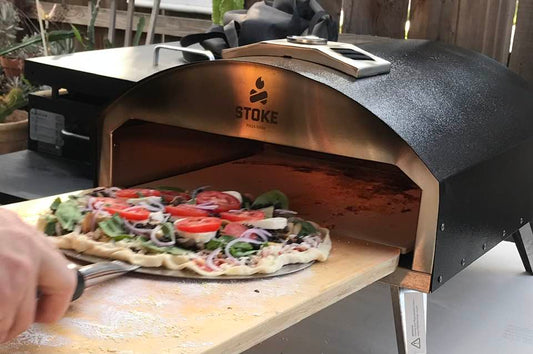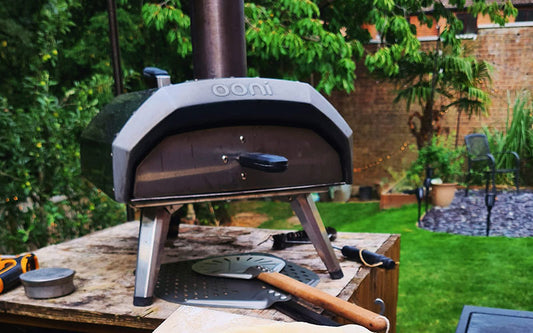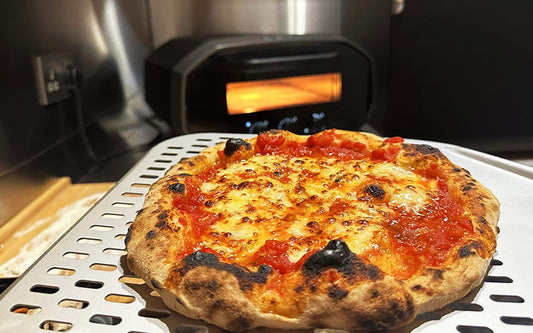When it comes to pizza ovens, gas or wood is the age-old question. While both have their pros and cons, there are certain situations where one may be more appropriate than the other.
With that said, this is truly a matter of preference. I have used Ooni Pro multi-fuel in the past. If you ask me if I could taste the wood smoke on my pizza, the answer would be – barely enough. Unless you are fixated on doing stuff the traditional way, a gas pizza oven would be a smarter purchase.
In short, gas-powered pizza ovens are the easier way to bake pizzeria-style pies at home. But the real question is – is easier necessarily better? To find out the answer, we will have to delve deeper into the nitty-gritty of gas and wood pizza ovens.
Benefits and Drawbacks of Gas-Fired Pizza Oven
Please note that everything I’m about to write is based on my observation and hands-on experience with different variants of Ooni.

Choosing between Ooni gas vs. wood is a real struggle for first-time buyers. Trust me, I have been there, and as someone who has recently switched to Ooni Koda 16, I believe I can give you some valuable insights.

First of all, gas-powered pizza ovens are much easier to use than their wood-fired counterparts. There’s a heat control dial that lets you easily turn the heat up and down. Controlling the temperature is 2x times easier on a gas-powered oven as opposed to a wood-fired oven, which requires you to constantly tend the fire.
The Benefits
The key reasons that convinced me to switch to gas are the following:
Easier Temperature Control
Pizzas, like any other baked good, are all about the right temperature. In general, gas ovens can’t get as hot as wood-fired ovens, but they are far easier to control. You don’t have to constantly tend the fire and check if it’s burning out of control like with a wood-fired oven. This saves you a lot of time and effort.
Ooni Koda max temp is 932 F or 500 C, which is the same as Ooni wood-fired ovens like Ooni Fyra or Karu.

But with wood and charcoal as your source of fuel, you have to make precise airflow adjustments and use high-quality wood pellets charcoal to get to the right temperature.
Next Read: Best Infrared Thermometer For Pizza Oven to Level Up Your Pizza Cooking!
Ooni gas oven comes with a heat dial that makes adjusting the heat a breeze. Also, starting the Koda is as easy as pressing and turning the knob.
Less Mess
No wood or charcoal means no soot build-up in the chimney or ash in the firebox to clean up.
This makes gas ovens easier to clean and maintain. It’s also better for the environment, and good or charcoal smoke emits high amounts of harmful particles and gases, which is detrimental to both the environment and your health.
Prolonged exposure to charcoal smoke has been linked to cancer, and even short-term exposure to wood smoke can trigger asthma. If you have already been diagnosed with respiratory problems, opting for a gas-powered pizza oven would be smarter.
Sleeker Design
Although all Ooni ovens are designed to be as sleek as possible, gas-powered pizza ovens tend to look sleek due to the absence of a door and a chimney.
Fuel Efficiency
Although the upfront cost of wood or charcoal per kg is lower than that of a propane tank, the gas is overall more economical due to its higher combustion efficiency.
The Drawbacks
Truth be told, there’s no legit drawback to using a gas-powered oven except maybe that it doesn’t give you the “authentic vibe” that wood-fired pizza ovens do. However, if you’re more concerned about the quality, taste, and ease of use, you can’t go wrong with a gas-powered pizza oven.
Benefits and Drawbacks of Wood-fired Pizza Oven
There’s no denying the fact that cooking in a wood-fired oven is an unmatched experience. The aroma of freshly cooked pizza combined with the rich, smoky flavor you get from cooking in a wood-fired oven is something that can’t be replicated.
If you are going to get an oven for making large quantities of pizza, investing in a wood-fired oven is definitely the way to go. The benefits of a wood-fired pizza oven are:
The Benefits
The Smoky Flavor

Yes, you can definitely taste the smoke, it’s very faint, and for me personally, it’s not worth the hard work. The food needs to be in the oven for at least 35 minutes to allow the smokiness to envelop the dish. Pizza in a wood-fired oven takes 90 seconds tops That’s not enough time to impart the flavor I am looking for.
However, for steaks, low and slow ribs, grilled seafood, or roasted veggies in your pizza oven, a wood-fired oven is the perfect option.
Better for Making a Big Batch of Pizza
Wood-fired ovens are a lot of work, but the experience is priceless. Managing the heat in a wood-fired oven takes skill and effort. If you bake two or three pizzas once in a while, a gas oven will do the trick. But if you intend to bake large batches, wood would be good enough.
Ideal for Windy Conditions
Firewood burns hotter than propane and natural gas, and it can make a difference in windy conditions. If your outdoor space is exposed to the elements, wood-fired pizza ovens are more effective at maintaining high flames against the wind than gas ovens.
The Drawbacks
On the downside:
- Wood-fired ovens are high maintenance, thanks to all the ash and soot that accumulates in the chimney and firebox.
- Inhaling the smoke for an extended period can cause serious respiratory issues.
- Maintaining a high flame requires you to constantly tend the fair, which can be a real chore if you manage everything, from food prep to tending the fire alone.
Pizza Oven Gas vs. Wood Comparison Chart
| Feature | Wood-fired Pizza Oven (Ooni Fyra) | Gas-fuelled Pizza Oven (Ooni Koda 16) |
| Mx temperature | 932°F (500°C) | 950°F / 510°C |
| Temperature Variation | +/- 50°F | +/- 25°F |
| Fuel source | Wood pellets or charcoal | Propane or natural gas |
| Pizza size | 12” | 12” and 16” |
| Temp adjustment | Has a built-in temperature gauge | Has a heat control knob |
| Pre-heating time | Around 45 minutes | Around 20 minutes |
| Cooking time (for a 12-inch pizza) | 60-90 seconds | Approx. 1 minute 30 seconds |
| Maintenance | Soot and ash build makes cleaning a bit time-consuming | Easy to clean as there’s no soot or ash to deal with |
| Cleanup Time | Around 2 hours to cool down and 15 minutes to remove the ash. | Around 1 hour to cool down, 5 minutes to wipe down the surface. |
| Pellets used | 2.5 lbs (1.13 kg) of hardwood pellets for every 10 pizzas | N/A |
| Taste Test Score* | 4.8/5 | 4.6/5 |
*Based on blind taste testing of 5 identical pizzas from each oven with 10 tasters rating on a scale of 1-5. We kept the toppings very simple – 2 out of the 5 pizzas had tomato sauce, mozzarella, ricotta, and basil. One had pesto and prosciutto. The other two were topped with parmesan, gorgonzola, tomato sauce, and Italian sausage.
We all unanimously agreed that the pizzas baked in the wood-fired oven had a very subtle hint of smokiness which elevated the whole experience. However, the smoky flavor was very subtle.
So, if you like your pizzas loaded with heavy toppings, you can opt for a gas-fired oven without feeling FOMO
Key Differences Between Gas and Wood-Fired Pizza Ovens
Still on the fence about whether to invest in a wood-fired or gas pizza oven? Here’s a quick comparison of the core aspects of each oven:
Fuel Source
Gas pizza ovens use natural gas or propane as their fuel source, while wood-fired ovens rely on wood pellets or charcoal. Ooni gas ovens allow one-click, instant ignition, and easy temperature control, but it’s very difficult to keep the flame from blowing out on a windy day.

Heating Time
The Ooni site mentions that their wood-fired ovens take 20 minutes to preheat to 932 degrees. Speaking from personal experience, that’s simply not true. It took me approx 45 minutes every single time.
My Ooni Fyra took significantly longer to preheat compared to Koda, likely because the pellets I wasn’t using weren’t burning evenly. Koda, on the other hand, takes 15-20 minutes to come to temperature.
Size
Ooni wood-fired ovens take up a little more space than gas ovens due to the chimney and firebox. That said, both gas and wood-fired Ooni ovens can be moved around easily on trolleys.
The 16″ Koda is quite large for a home oven, but it’s perfect if you want to cater parties and gatherings. However, if your family consists of just 2-3 people at most, then the 12″ version might be an ideal choice. Fyra only comes in one size, which is 12″. If you have a large family, then the 12″ Fyra may be too small for your needs.
Cooking Time
Both ovens take anywhere around 90 seconds to 2 minutes for Neapolitan-style pizza. A wood-fired oven generally takes about 30 seconds less as the flames are more intense.
Maintenance
With wood-fired ovens, you will need to empty the ash after every use and sweep the chimney once a week. Periodic deep cleaning is important to prevent soot buildup.
Gas ovens don’t produce any ash or soot. Therefore, these ovens are easier to maintain as they don’t require any maintenance except basic cleanup.
Safety
Wood-fired ovens are more dangerous as they produce ash and soot that can get in your eyes and lungs. Although gas ovens are much safer than wood-fired ones, they can still pose a risk.
You must follow the instructions carefully when cleaning and maintaining them to avoid any accidents or injuries. Safety is a concern for both types of ovens.
Pizza Taste
When it comes to pizzas, very few people can tell the difference between the taste of wood-fired and gas-powered pizza. I am not one of them. The reason behind this is pretty straightforward.

Pizzas won’t stay in an oven long enough to absorb the smoky flavor. However, as far as BBQ meat or veggies are concerned, the smooth wood smoke or charcoal flavor is unmistakable.
Cost
In general, wood-fired ovens are more expensive than gas ovens. However, the 16″ gas-fuelled Koda 16 is costlier than the 16″ Fyra. If you can shell out around 200 bucks more, I would suggest you go with Ooni Karu instead.
It’s a multi-fuel oven, allowing you to switch between wood, charcoal, and propane or natural gas for fuel. The latter two are cheaper than wood so you can save money on running costs.
Final Verdict: Which One is Better For You, a Gas or Wood Fire Pizza Oven?
For small-scale domestic use, gas ovens are a far better option in terms of ease of use. Unless you have some god-like sensory abilities, you won’t find a huge difference in taste between wood-fired and gas-fired pizza.
However, if you are worried about high winds affecting the flames, you will have an easier time working with a wood-fired oven. It’s also a more versatile oven for barbecues and steaks, thanks to the delicious smoky flavor it infuses into the dishes.
The Takeaway
At the end of the day, it all boils down to your needs and preferences. If you want something that is easier to use and can produce delicious pizza without much effort, then a gas oven is the way to go.
However, if you are looking for something more authentic and have an open space in your backyard for the installation of a wood-fired oven, then go for it.




